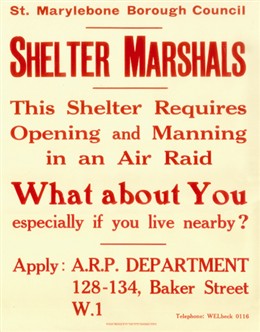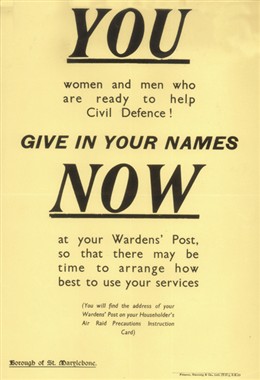Recruiting in St Marylebone

Civil Defence recruitment poster
Copyright Westminster City Archives

Civil Defence recruitment poster
Copyright Westminster City Archives
By Rory Lalwan
Preparations for the local civil defence of British towns and cities against enemy aerial bombardment had begun in earnest following the Munich Crisis of 1938. The Air Raid Precautions Act of 1937 had previously directed that all local authorities prepare and submit to the Home Office an air-raid precautions scheme, for "the protection of persons and property from injury and damage in the event of hostile attack from the air"
Proposed for London was a two tier system of civil defence: the London County Council would direct the fire and ambulance services and a number of other functions, such as the Heavy Rescue Service and rest centres for the homeless; the cities of London and Westminster and the London metropolitan boroughs would, under Home Office scrutiny, each make their own arrangements for air-raid precautions.
In the months preceding and immediately following the outbreak of war in September 1939, local authorities proceeded with urgency to implement their air-raid precaution schemes. There was a fear however that no matter how thorough and efficient defensive measures might be, a large-scale enemy air attack upon London could deliver a devastating, knock-out blow, a huge loss of life and a psychological shock that would demoralise and disorientate surviving Londoners.
The St Marylebone Borough Council, like other London boroughs, began their recruitment and training of volunteer civil defence personnel. One such volunteer was E. Ita Ekpenyon who, at his post near his home in Great Titchfield Street, was to serve his borough with distinction.